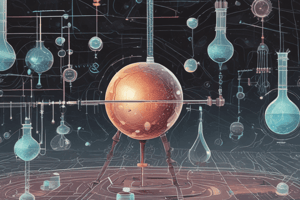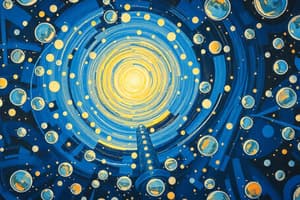Podcast
Questions and Answers
The activity with the bottle and water demonstrates that air:
The activity with the bottle and water demonstrates that air:
- Can be compressed into a smaller volume.
- Is heavier than water.
- Occupies space. (correct)
- Has no mass.
Which of the following is NOT a characteristic of gases, based on the provided information?
Which of the following is NOT a characteristic of gases, based on the provided information?
- Gases can be compressed easily.
- Gases occupy all the space available to them.
- Gases have a fixed volume. (correct)
- Gases can easily flow in all directions.
Which of the following examples represents a permanent change in the state of matter?
Which of the following examples represents a permanent change in the state of matter?
- Boiling water to produce steam.
- Burning wood to produce ash. (correct)
- Water freezing into ice.
- Dry ice sublimating into carbon dioxide gas.
Which of the following statements about the states of matter is TRUE?
Which of the following statements about the states of matter is TRUE?
Which of the following is NOT an example of a gas?
Which of the following is NOT an example of a gas?
What does the term 'sublimating' mean in the context of the provided text?
What does the term 'sublimating' mean in the context of the provided text?
Based on the information provided, which of the following is a CORRECT comparison between liquids and gases?
Based on the information provided, which of the following is a CORRECT comparison between liquids and gases?
The weak forces of attraction between gas molecules explain which of the following properties?
The weak forces of attraction between gas molecules explain which of the following properties?
Which of the following phenomena BEST exemplifies the concept of a temporary change in the state of matter?
Which of the following phenomena BEST exemplifies the concept of a temporary change in the state of matter?
What is the MAIN reason gases can be compressed easily, compared to liquids and solids?
What is the MAIN reason gases can be compressed easily, compared to liquids and solids?
Flashcards are hidden until you start studying
Study Notes
Characteristics of Gases
- Molecules in gases are loosely packed and have weak forces of attraction between them.
- Gases occupy all the space available to them.
- Gases do not have a fixed shape and can take the shape of their container.
- Gases do not have a fixed volume.
- Molecules in gases have lots of space between them, making them easily compressible.
- The force of attraction between gas molecules is very low, allowing them to flow easily in all directions.
- Examples of gases include oxygen, carbon dioxide, nitrogen, water vapour, and cooking gas.
Demonstration of Gases Occupying Space
- An empty glass bottle appears empty but is actually filled with air.
- When the bottle is tilted, air bubbles escape, allowing water to fill the space.
- This demonstrates that air occupies space and fills all available space in the bottle.
Changing States of Matter
- States of matter can be changed into one another by heating or cooling.
- Heating a solid (e.g., ice) can change it into a liquid (e.g., water).
- Further heating the liquid can change it into a gas (e.g., water vapour).
- Cooling the gas can change it back into a liquid, and further cooling can change it back into a solid.
- This shows that the three states of matter are interchangeable.
- Changes in states of matter can be categorised as physical or chemical changes, depending on whether they are temporary or permanent.
Studying That Suits You
Use AI to generate personalized quizzes and flashcards to suit your learning preferences.




